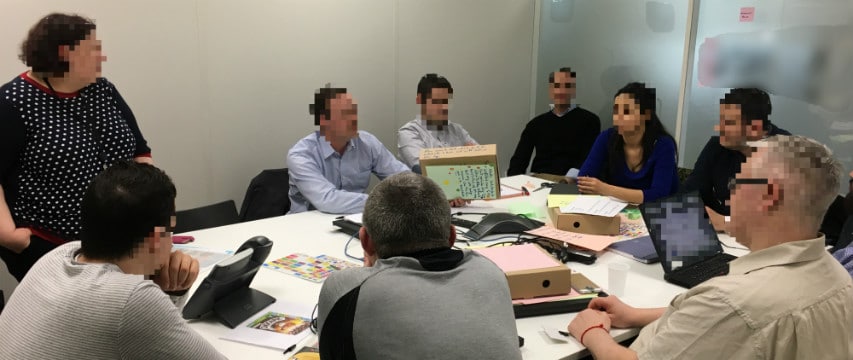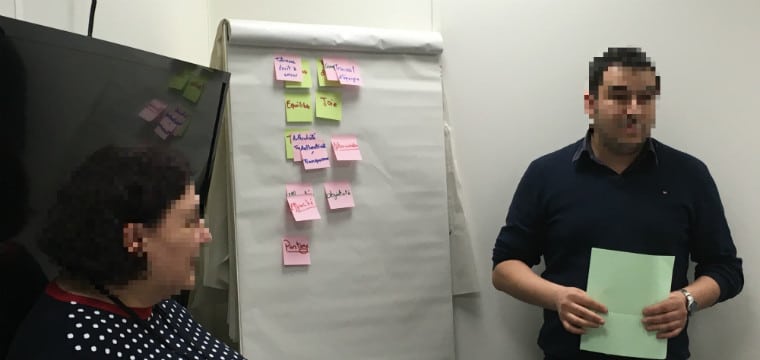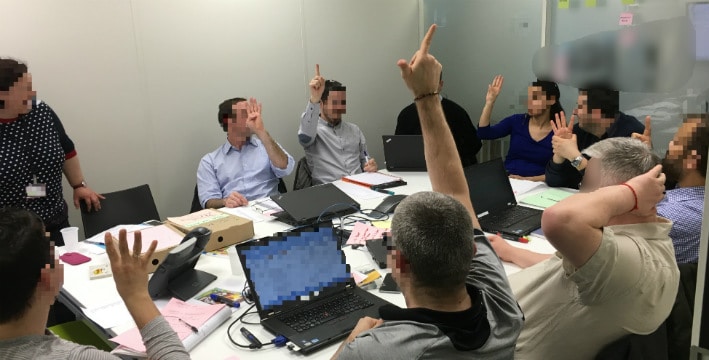
Sprint 0 continues, and after our first workshop coaching framework, we have decided with the team of coaches to carry out an alignment workshop where the team will have the opportunity to synchronize both in terms of the direction to be taken and its internal operating rules. After preparing the content with my colleagues, I leave the animation of the workshop in their hands to stay a little behind in the posture of an observer: I observe and if necessary, I intervene! Here is the feedback! 😉

We have decided to divide this workshop into 2 parts:
- Alignment with the product vision
The goal is for the team to agree on the vision of the product it intends to achieve.
To do this, we plan to carry out a Product Box workshop of about 1 hour.
- Alignment with team values
The objective is for the team to define a framework for collaboration.
To do this, we plan to use the same concept as for the definition of expectations in the previous workshop by defining the values – described by measurable behaviors – of the team.
The Product Box

I have described the concept of the workshop in a previous post. So I invite you to go take a look if you do not know! 🙂
The framework of the workshop used this time was:
- 2 build iterations (15 min)
- 2 reviews (15 min)
The variant compared to the case described in my article on the Product Box is that the 2nd iteration was carried out by the whole team on a common box.
The first iteration review gave rise to interesting exchanges in terms of the product perspective. Indeed, one team listed the functionalities that the product should contain while the other tried to represent its contribution to the user. During the debriefing, it was then time to help the participants get their heads out of the functionalities as such and to open their minds to the objective of a product: to meet a customer need. Moreover, this could have been an opportunity to recall the data from the chaos report of the 2000s describing that a large number of functionalities were little or never used! Quite simply because they did not meet a need and therefore a use by users!
Note: as an observer, what I would take away from this part is that it is important to clearly clarify the objective of the workshop in order to properly focus the participants. Indeed, the energy was not always there, which potentially gave a rather mixed result afterwards.
How to fail the project?

Feeling a dwindling energy, I invited the participants to bring a blank A4 sheet and answer the following question:
What would be the 10 wonderful techniques you would use to make this project fail?
After a few seconds of hesitation on the part of the group, everyone left to draw up their list.
I insisted that the answers be as concrete as possible:
I would not give information to X during Sprint Planning
I would not test my developments
I would change the team every week
…
The objective of this phase was multiple:
- Allow each team member to self-denounce on a non-constructive behavior: in this way, we especially want to reduce the probability that each element mentioned is actually put in place.
- Give a little air to the team: this unusual question led to some very interesting laughter and discussion around everyone's answers.
This part allowed the team to be able to go on a break in a good mood and to my great surprise the exchanges continued coffee in hand! 😉
Team values

After the break, we came back to talk about serious things: around what values was the team going to unite?
In the same way as for the definition of the expectations of the first workshop, it was important to describe the values by behaviors allowing to explain what we put behind the term.
The process used was as follows:
- Each participant describes 5 values which seem to him the most important for the functioning of the team. He writes one on a Post-it. (about 5′)
- The participants are then invited to form pairs and to select once again the 5 values which seem to them the most important for the functioning of the team. I specify that the description of the behaviors takes on its importance here in order to be able to argue with measurable and understandable elements. (about 7′)
- Sharing of each pair on the 5 selected values accompanied by the description of the associated behaviors. (around 10')
- Grouping of similar or close values. (about 2′)
- Selection of the 5 values or groups of values for the operation of the team. (around 20')
It is always surprising to me to see the debates that can emerge around the subject of values. Despite my intrinsic interest in them, at some point it was necessary to come to a decision in order to be able to move forward in the workshop. To do this, I proposed a 5-level version (5 fingers of the hand) of the Decision protocol of the Core Protocols. Now I think the basic version is more than enough.
Here is a description:
- Make a concise, concrete and achievable proposal.
- Vote simultaneously by a show of hands on a 3-level scale: For (thumbs up), Against (thumbs down), follower (flat hand).
- For every vote Against, we use the Resolution protocol which consists of determining the elements that would allow Against to switch at least to follower.
ROTI (Return On Time Invested)

To end the workshop, we proceeded to a simple ROTI.
For people who are not familiar with this tool, ROTI makes it possible to obtain feedback from participants on the “time spent / value obtained” ratio in the form of a show of hands:
- 5: Value obtained << Time spent: « Excellent. I will really benefit from this meeting! »
- 4: Value obtained < Time spent: “ Good. An above average meeting! »
- 3: Value obtained = Time spent: “ Mean. I didn't waste my time, but nothing more! »
- 2: Value obtained > Time spent: “ Useful. But it wasn't worth all the time I spent there! »
- 1: Value obtained >> Time spent: “ Useless. I didn't learn anything, I really wasted my time! »
The death knell of the votes fell, we came out with a rather mediocre result of 2.75! 😕
The coaches who led most of the workshop therefore began to ask for explanations from the participants who voted 1 and 2.
During the exchanges, I discreetly approached the Paper Board and wrote these 3 words: Transparency, Opening and Patience. Indeed, this corresponded to the expectations of the coach with respect to the team defined and accepted during the previous workshop. Then I decided to intervene to discuss with the participants and also support my fellow coaches in the face of this not very encouraging result at first glance.
The remarks made were quite similar:
I didn't expect to do this type of exercise, I thought we were going to work on the Product Backlog!
We have to move forward, we are falling behind and the deadlines are not changing!
…
Note: To my great surprise, the manager was among the people who gave a 4 to the ROTI whereas one could suppose the opposite in a “usual” pattern.
To which I cordially replied:
I understand your desire to want to move forward, but I would like to remind you of the coaching contract we signed together.
I have once again entered the 3 values corresponding to our expectations of you and in these you will find the patience, or to give you time to do things right. Indeed, these synchronization workshops aim to help you go in the right direction from the start to avoid working for nothing: personally I don't like running at full speed head down at the risk of hitting a wall! 🙂
In addition, I would like to take up one of the values of the Agile Manifesto: collaboration rather than contractual negotiation. We, as coaches, wish here to weave a link of collaboration with you and not of client-supplier. We are also committed in terms of the means to best support you. Do not hesitate to let us know your feelings if the content of the workshops does not suit you or if you do not see the interest, we do not claim to know everything better than you and quite the contrary. , we are here to learn together.
In the same vein, do you need us to start working on the Product Backlog? You are much more qualified than us in terms of technical content, our added value potentially lies in the method on which I encourage you to contact us as you progress. Moreover, we made a commitment to be available to help you.
My desire was therefore to defuse this chronic behavioral mechanism of wait-and-see attitude of the coachees vis-à-vis the coaches. Indeed, empowerment being one of the key objectives of coaching, I found it important to empower team members from the start so that they become actors in their support rather than being subjected to it.
The workshop then ended with constructive exchanges on the follow-up of the events.
Conclusion
This second workshop was very enriching for me. Not so much in terms of content (I remain a big fan of the value and behavior orientation) but especially in terms of the exchanges that have emerged from it. Indeed, the final ROTI was a great source of learning and exchanges with the team and the opportunity to concretize the real coaching relationship. As the Agile Manifesto says, the tools are there only to support individuals and interactions and for once, there were interactions! 😉
Team alignment is essential to ensure a start in the best conditions. Now, you will often come across people who are eager to get their hands dirty, wanting to rush headlong into work. It is important to help them see the distance on the shore rather than letting them dive into their underwater epic to finally build a real collaborative relationship. 🙂






